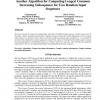Free Online Productivity Tools
i2Speak
i2Symbol
i2OCR
iTex2Img
iWeb2Print
iWeb2Shot
i2Type
iPdf2Split
iPdf2Merge
i2Bopomofo
i2Arabic
i2Style
i2Image
i2PDF
iLatex2Rtf
Sci2ools
97
Voted
FCS
2006
2006
Another Algorithm for Computing Longest Common Increasing Subsequence for Two Random Input Sequences
We have previously developed several algorithms which deal with different input sequence scenarios respectively. In this paper, another sequential algorithm for computing Longest Common Increasing Subsequence for two random input sequences is reported. It runs in O(m n log p) time complexity and takes space of O(2(m + n + 1) p), where m and n are the length for two input sequences respectively, and p is the length of the final Longest Common Increasing Subsequence. Parallelization allows us to further reduce time and space. This algorithm has significant applications in the area of Computational Biology in manipulating the genomic sequences.
| Added | 31 Oct 2010 |
| Updated | 31 Oct 2010 |
| Type | Conference |
| Year | 2006 |
| Where | FCS |
| Authors | Yongsheng Bai, Bob P. Weems |
Comments (0)

